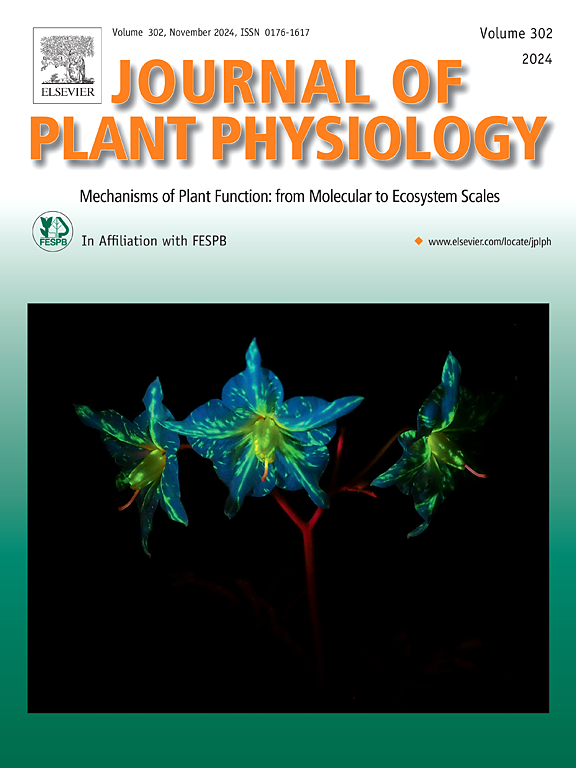Unlocking the role of novel primary/di-amine oxidases in crop improvement: Tissue specificity leads to specific roles connected to abiotic stress, hormone responses and sensing nitrogen
IF 4
3区 生物学
Q1 PLANT SCIENCES
引用次数: 0
Abstract
Genetic improvements of solanaceous crops for quality and stress responsive traits are needed because of the central role vegetables and fruits have in providing nutrients to human diets. Copper amine oxidase (CuAO) encoding genes involved in metabolism of primary/di-amine nitrogenous compounds, play a role in balancing internal nitrogen (N) pools especially when external N supply fluctuates during growth, development and environmental stresses. In the present study, we investigated the occurrence, molecular evolution and possible role(s) of these unknown genes in tomato crops. Multiple genome-wide bioinformatics approaches led to the identification of eight bona fide CuAO genes (SlCuAO1–SlCuAO8) in the tomato genome with gene numbers like those in Arabidopsis and rice indicating their conserved functional relevance with a tandemly duplicated SlCuAO6-SlCuAO7 pair at chr.9. A conserved intron-exon size and phase distribution for SlCuAO2, 3, 4 pairs are similar to a recently identified single duckweed SpCuAO1 orthologue gene indicating its evolutionary conservation. Synteny analysis showed their closest association to Arabidopsis and but not with rice. Transcriptome data indicated that gene expression for about six genes (SlCuAO1, 2, 3, 4, 6, 7) is root specific, fruit specific for SlCuAO5 and flower specific for SlCuAO8 thus indicating amine oxidation is variable across tissues with a prominance in the root tissue. The majority of CuAO genes are negatively regulated by methyl jasmonate. Positive regulation, however, involves CuAO3/8. Transcript analysis of the ethylene-deficient transgenic lines indicated that ethylene is required for activation of SlCuAO4. CuAO4 and CuAO5 exhibited most significant tissues-independent gene expression responses across various nitrogen regimes. Drought, heat and N stress identified CuAO5 as an overlapping highly expressed gene that corroborates with putrescine accumulation for free and conjugated forms with an opposite abundance of bound forms. Taken together our study highlights new insights into the roles of copper amine oxidation genes and identifies CuAO5 as a multiple stress induced gene that can be used in genetic improvement programs for combining heat, drought and nitrogen use efficiency related traits.
揭示新型初级/二胺氧化酶在作物改良中的作用:组织特异性导致与非生物胁迫、激素反应和感知氮有关的特定作用。
由于蔬菜和水果在为人类饮食提供营养方面发挥着核心作用,因此需要对茄科作物的品质和抗逆性状进行遗传改良。铜胺氧化酶(CuAO)编码基因参与初级/二胺含氮化合物的代谢,在平衡内部氮(N)池方面发挥作用,尤其是在生长、发育和环境胁迫期间外部氮供应波动时。在本研究中,我们调查了这些未知基因在番茄作物中的出现、分子进化和可能的作用。通过多种全基因组生物信息学方法,我们在番茄基因组中鉴定出 8 个真正的 CuAO 基因(SlCuAO1-SlCuAO8),其基因编号与拟南芥和水稻中的基因编号相同,表明其功能相关性是一致的,在 chr.9 上有一对串联重复的 SlCuAO6-SlCuAO7 基因。SlCuAO2、3、4 对保守的内含子-外显子大小和相位分布与最近发现的单个鸭茅 SpCuAO1 直向同源基因相似,表明其进化保守性。合成分析表明,它们与拟南芥的关系最密切,而与水稻的关系则不密切。转录组数据表明,约有六个基因(SlCuAO1、2、3、4、6、7)的基因表达具有根特异性,SlCuAO5的基因表达具有果特异性,SlCuAO8的基因表达具有花特异性,这表明胺氧化作用在不同组织中是可变的,而在根组织中表现突出。大多数 CuAO 基因受茉莉酸甲酯的负调控。而正向调节则涉及 CuAO3/8。乙烯缺陷转基因品系的转录本分析表明,SlCuAO4 的激活需要乙烯。CuAO4 和 CuAO5 在各种氮素胁迫下表现出最显著的不依赖于组织的基因表达响应。干旱、高温和氮胁迫发现 CuAO5 是一个重叠的高表达基因,它与游离型和共轭型的石灰华积累相一致,而结合型的石灰华积累则相反。总之,我们的研究强调了对铜胺氧化基因作用的新认识,并确定 CuAO5 是一种多重胁迫诱导基因,可用于遗传改良计划,将高温、干旱和氮利用效率相关性状结合起来。
本文章由计算机程序翻译,如有差异,请以英文原文为准。
求助全文
约1分钟内获得全文
求助全文
来源期刊

Journal of plant physiology
生物-植物科学
CiteScore
7.20
自引率
4.70%
发文量
196
审稿时长
32 days
期刊介绍:
The Journal of Plant Physiology is a broad-spectrum journal that welcomes high-quality submissions in all major areas of plant physiology, including plant biochemistry, functional biotechnology, computational and synthetic plant biology, growth and development, photosynthesis and respiration, transport and translocation, plant-microbe interactions, biotic and abiotic stress. Studies are welcome at all levels of integration ranging from molecules and cells to organisms and their environments and are expected to use state-of-the-art methodologies. Pure gene expression studies are not within the focus of our journal. To be considered for publication, papers must significantly contribute to the mechanistic understanding of physiological processes, and not be merely descriptive, or confirmatory of previous results. We encourage the submission of papers that explore the physiology of non-model as well as accepted model species and those that bridge basic and applied research. For instance, studies on agricultural plants that show new physiological mechanisms to improve agricultural efficiency are welcome. Studies performed under uncontrolled situations (e.g. field conditions) not providing mechanistic insight will not be considered for publication.
The Journal of Plant Physiology publishes several types of articles: Original Research Articles, Reviews, Perspectives Articles, and Short Communications. Reviews and Perspectives will be solicited by the Editors; unsolicited reviews are also welcome but only from authors with a strong track record in the field of the review. Original research papers comprise the majority of published contributions.
 求助内容:
求助内容: 应助结果提醒方式:
应助结果提醒方式:


